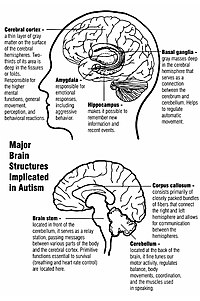
Photo from wikipedia
The broader autism phenotype (BAP) is a collection of sub-diagnostic autistic traits more common in families of individuals with autism spectrum disorder (ASD) than in the general population. BAP is… Click to show full abstract
The broader autism phenotype (BAP) is a collection of sub-diagnostic autistic traits more common in families of individuals with autism spectrum disorder (ASD) than in the general population. BAP is a latent construct that can be defined using different domains, measured using multiple instruments, and reported using different techniques. Therefore, estimates of BAP may vary greatly across studies. Our objective was to systematically review studies that reported occurrence of BAP in parents of children with ASD in order to quantify and describe heterogeneity in estimates. We systematically searched PubMed and Scopus using PRISMA guidelines for studies quantifying percentage of parents of children with ASD who had BAP. We identified 41 studies that measured BAP in parents of children with ASD. These studies used eight different instruments, four different forms of data collection, and had a wide range of sample sizes (N = 4 to N = 3299). Percentage with BAP ranged from 2.6% to 80%. BAP was more prevalent in fathers than mothers. Parental BAP may be an important tool for parsing heterogeneity in ASD etiology and for developing parent-mediated ASD interventions. However, the variety in measurement instruments and variability in study samples limits our ability to synthesize estimates. To improve measurement of BAP and increase consistency across studies, universal methods should be accepted and adopted across studies. A more consistent approach to BAP measurement may enable efficient etiologic research that can be meta-analyzed and may allow for a larger evidence base that can be used to account for BAP when developing parent-mediated interventions.
Journal Title: Journal of Child and Family Studies
Year Published: 2018
Link to full text (if available)
Share on Social Media: Sign Up to like & get
recommendations!